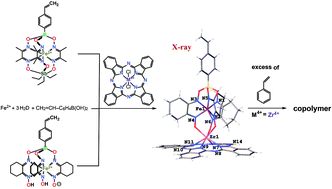The article with participation of NIOCh's researchers is published in Dalton Transactions (IF 4,39)
Hybrid iron(ii) phthalocyaninatoclathrochelates with a terminal reactive vinyl group and their organo-inorganic polymeric derivatives: synthetic approaches, X-ray structures and copolymerization with styrene
Semyon V. Dudkin, Alexander S. Chuprin, Svetlana A. Belova, Anna V. Vologzhanina, Yan V. Zubavichus, Polina M. Kaletina, Inna K. Shundrina, Elena G. Bagryanskaya and Yan Z. VoloshinDalton Trans., 2022, V. 51, Issue 14, Pages 5645-5659
First published on 09 Mar 2022

Abstract
Hybrid metallo(IV)phthalocyaninate-capped tris-dioximate iron(II) complexes (termed as “phthalocyaninatoclathrochelates”) with non-equivalent apical fragments and functionalized with one terminal reactive vinyl group were prepared for the first time using three different synthetic approaches: (i) transmetallation (capping group exchange) of the appropriate labile boron,antimony-capped cage precursors, (ii) capping of the initially isolated reactive semiclathrochelate intermediate, and (iii) direct one-pot template condensation of their ligand synthons on the iron(II) ion as a matrix. The obtained polytopic cage complexes were characterized using elemental analysis, 1H NMR, MALDI-TOF MS and UV–vis spectra, and the single-crystal X-ray diffraction experiments. One of the obtained vinyl-terminated iron(II) phthalocyaninatoclathrochelates and its semiclathrochelate precursor were tested as monomers in a copolymerization reaction with styrene as the main component. These vinyl-terminated (semi)clathrochelate iron(II) complexes were found to be successfully copolymerized with this industrially important monomer, affording the intensely colored copolymer products. Because of a low solubility of the tested zirconium(IV) phthalocyaninate-capped tris-nioximate monomer in styrene as a solvent, a molar ratio of 1 : 500 was used. The obtained copolymer products and the kinetics of their formation were studied using GPC, FTIR, UV–vis, TGA and DSC methods. Even at such a low concentration of the Fe,Zr-binuclear metallocomplex component, an increase in the rate of the UV-light degradation of the organo-inorganic products, as well as in their thermal stability, was observed.
Альметрики:


